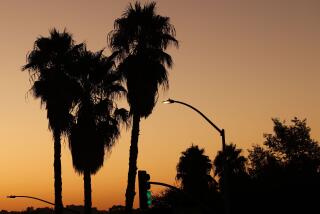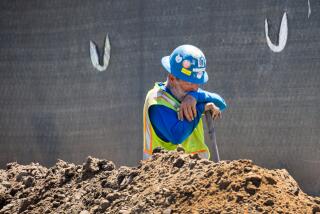From Outages to Nosebleeds, Heat Is Taking Its Toll
VAN NUYS — Record-tying heat baked the San Fernando Valley again Friday, causing power outages and setting organizers to worry about the health of spectators when the Van Nuys air show opens today, with the temperature expected to reach 106.
Chatsworth hit 105 Friday, equal to the temperature of the hottest July 17 on record, in 1988, and in Lancaster it was 107, a tie with the record set in 1961.
It was 108 in Palmdale, 102 in Burbank, 100 in Woodland Hills and 99 in Newhall. Downtown saw a record 98, the hottest temperature for the date in 73 years.
Forecasters say that a massive upper-level high-pressure system camped out over southern Nevada is to blame. Air sinks under the high-pressure system, “and heats it up real good, assuming you like it warm,” said Mark House, a meteorologist with WeatherData Inc., which provides forecasts for The Times.
That system is expected to keep things almost intolerably hot for at least a few more days.
“This is going to continue through the weekend at least,” House said. “There’s some hope for cooling sea breezes, but those didn’t show up [Friday].”
Searing temperatures may also have contributed to the death of Patricia J. Vangaston, 65, of Lakewood, whose body was found by a CHP officer Friday not far from her car on Interstate 40 in San Bernardino County. The cause of death was not known, but there were no signs of trauma and temperatures in the area reached 120 degrees Friday. An autopsy was pending.
There were about 400 power outages scattered throughout the Valley, but none that covered large areas, said Department of Water and Power spokesman Walter Zeisl. “Over all, it’s not that much different than a regular day,” he said.
At Van Nuys Airport, as temperatures hit 104 Friday, preparations were being made for what is expected to be one of the hottest events in the 35-year history of the air show.
Rows of portable cots were being set up in a hangar converted into a medical center. Stockpiles of aspirin, bottled water, Gatorade and Band-Aids were also in abundance. “Water buffalos,” military-style tanks scattered about the grounds, will serve as human water troughs. And tents were being set up with water misters to make a cooling spray.
Chad Smith, Red Cross coordinator for the event, joked that the most popular exhibit would be the B-1 Bomber with its 136-foot, 8 1/2-inch wingspan, offering the largest amount of shade anywhere on the sun-baked airport runways.
“You need to get the kids out of the sun,” Smith said. “There’s going to be 75 airframes from one end of the show to the other and they all make great umbrellas. And you thought those wings were for flying? Ha!”
Show managers have doubled the number of shaded rest areas. A hangar and three outdoor canopies, all with tables and chairs for relaxing and cooling down, are placed strategically about the grounds.
The number of shuttle buses also has been doubled to 60. While most of them do not have air conditioning, the increased number of buses is expected to reduce delays in waiting for a ride from remote parking lots to the show. A misting tent is set up at the shuttle assembly area to cool riders before they depart.
As many as 300,000 people are expected to flock to the show--the only air show in Los Angeles--which draws the second-largest crowd of any single event in the city, after a downtown Broadway street festival, said Ron Kochevar, airport general manager.
The forecast is for clear, sunny and hot weather through the second day of the air show Sunday.
Smith said that the effects of the heat can be easily countered with proper preparation and understanding. “Just standing still [in the sun] is like running a mile, burning up glucose like crazy,” Smith said, adding that the temperature rises even higher with reflected heat rising from the pavement.
He said the greatest precautions should be taken by people who have underlying medical problems, such as respiratory and cardiac conditions or diabetes. The young and the elderly also need to be closely watched by companions, Smith said. “They should all come, but they need to be aware of the stress that heat produces just standing still.”
Certain types of drugs, including anti-depressants and blood pressure medications, can interfere with proper body temperature regulation, said Dr. Cheryl Lee, an emergency room physician at Glendale Adventist Medical Center.
Drinking plenty of liquids is the key to coping with the heat, experts say. Smith and others advise that even people in normal health should drink at least a half gallon of water, following a regimen of drinking before they feel thirsty.
Beer will be in abundance at the show, but experts said visitors should avoid drinking too much alcohol in hot weather. They also recommend attendees eat a decent breakfast to ensure they will have enough strength to endure the heat.
Leave the tank top at home and cover up instead with light-colored, loose-fitting clothing and a hat with a wide brim, recommends Dr. Jonathan Fielding, director of public health and health officer for Los Angeles County. Apply sunblock 30 to 60 minutes before arriving at the air show and reapply it every few hours to avoid sunburn.
While show-goers prepare to meet the challenges of Aviation Expo 98, youngsters and their teachers attending summer school on Friday were chalking up their own lessons on surviving the heat wave.
At Hart Street Elementary School in Canoga Park, Tomas DeAlda was teaching geography to 28 perspiring fourth-graders in a classroom broiling at 95 degrees. His classroom, like most at the school, will not have an air conditioner until September. The children were making a valiant effort to stay focused, but the heat was overpowering.
After disrupting the class, one boy was sent to the back of the room where he fumbled with a pencil and eventually started crawling on the floor. Across the room a girl quietly departed from the lesson to fold a sheet of paper into a boat, and perhaps set her imagination afloat in cooler climes.
The shades were drawn, the lights off and a tall fan blew down on the children like car exhaust.
“It just blows hot air,” DeAlda said. “It’s more psychological than anything. With the air moving around and the lights off, the kids feel cooler, even if they aren’t.”
A table at the back of the room held two dozen water bottles that the children have been carrying to school since the heat wave began earlier this month. DeAlda, who recently transferred from an air-conditioned classroom in East Los Angeles, said hot kids are much more difficult to teach than cool kids.
“They get ticked off a little easier--emotions and tempers run high. I find there is a lot more pushing and name calling,” he said. “I find myself on a shorter fuse than usual. If it was cooler I might tolerate more things.”
School nurse Helen Nelson says the heat is so bad that it’s causing nosebleeds.
“The children are dehydrated, so I stop the bloody noses by giving them water,” she said. “Some of the kids are not sleeping well because they don’t have air-conditioners at home. We have some very tired students that need naps sometimes.”
On the other side of the campus, Irma Marquez was reading a story to her second-grade classroom in an island of comfort. There, an air conditioner filled the bungalow classroom with its benevolent hum and cool air. The children were attentive, happy and obedient.
“I’m kind of lucky,” Marquez said. “I’ve always had air-conditioning. I don’t have to worry about bleeding noses and headaches. It makes a huge difference. I’ve been in other classrooms and it’s horrible.”
Although low winds have kept fire danger at acceptable levels in recent days, the heat is drying out brush and creating ideal fire conditions for later in the summer, said Los Angeles Fire Department spokesman Jim Wells.
“With the heat drying out the brush like it is, unless we get rain soon, it will make for a very long and dangerous summer,” Wells said.
Staff writer Stephanie Stassel and correspondent Patrick Kerkstra contributed to this story.
More to Read
Sign up for Essential California
The most important California stories and recommendations in your inbox every morning.
You may occasionally receive promotional content from the Los Angeles Times.










